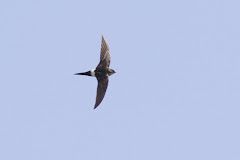Honey Buzzards are very common in Scandinavia and, during my time in Copenhagen, I have been lucky enough to see hundreds of these fantastic birds of prey. They are highly migratory, wintering in sub-Saharan Africa, and it is at migration time when they are most visible (they are very difficult to see during the breeding season). At this time of year they arrive back on their breeding grounds and my local patch of Sydvestpynten is a good place to watch them arriving on warm spring days. They do not rely completely on thermals to migrate and have no problem crossing stretches of water so, as soon as the weather warms up from mid-May, they set off. Many of the Honey Buzzards arriving at SVP have set off over the water from further south (from Stevns or Møns) and their journey across the water probably takes around 30-60 minutes depending on their starting point. Yesterday I was at Klydesøen early on a sunny morning (where, incidentally, the water levels are very high - not great for waders) and, at around 0940 I sighted 6 Honey Buzzards coming in off the sea... With the sun shining and the temperatures warming up nicely, I knew the migration was starting so I legged it down to SVP to watch them. In just over an hour (0950-1100) I counted 66 Honey Buzzards powering across the water with active flight and arriving at just a few metres height. They arrived on quite a broad front from Avedøre in the west to Dragør in the east but many came right over my head. A wonderful sight and one that tells us that summer is almost here....!
A large flock (60+) of Blue-headed (nominate
flava)and the Fenno-Scandian subspecies
thunbergi Yellow Wagtails in the horse fields were a nice end to the morning.
Photo: a newly arrived male Honey Buzzard



2 comments:
Wow! 60 Honey Buzzards! And I am over joyed when I see my one Common Buzzard. I would be in seventh heaven where you are.
Hi Kerry. Yes, but yours stays put! These Honey Buzzards fly over and disappear deep into the Scandinavian forests. I probably won't see any more until August/September when they begin their journey south... :-(
Post a Comment